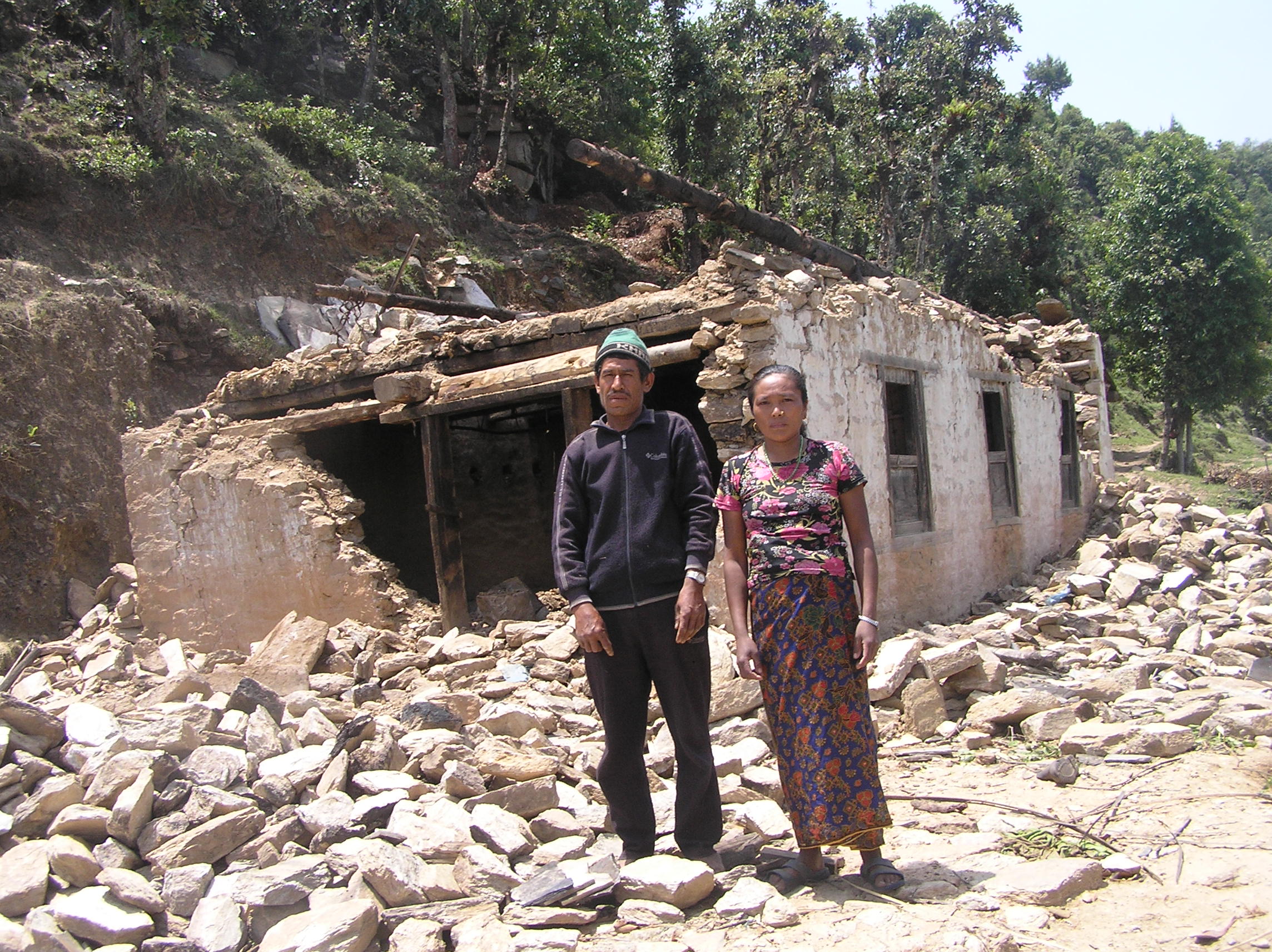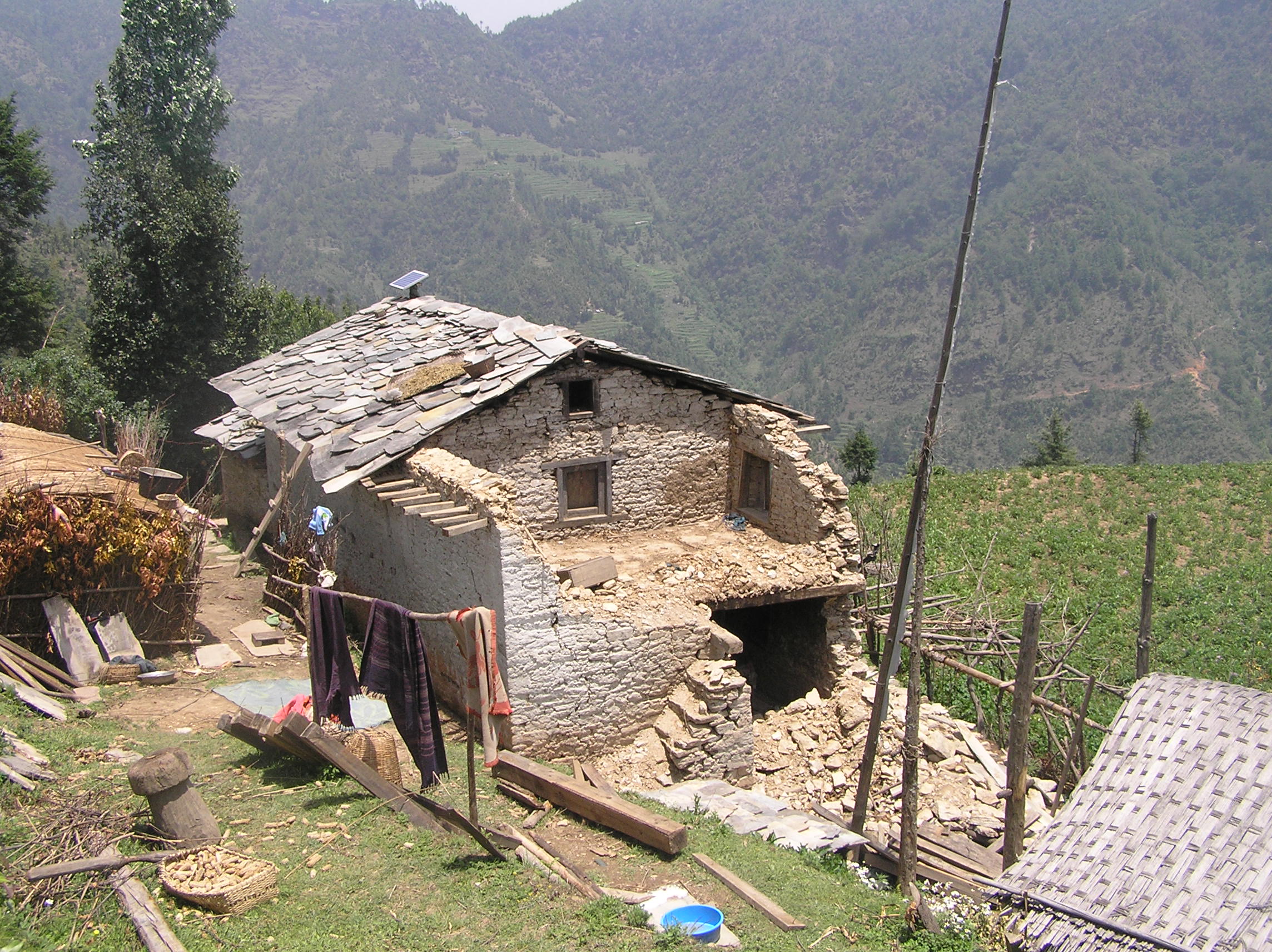2017:
Tijdens onze reis naar Duble hebben we diverse gesprekken gehad, onder andere met een ingenieur en regeringsambtenaar. Beiden waren in de omgeving van Pokhali om de herbouw te inspecteren. Door de regering bleek hier in totaal 5 jaar voor te zijn uitgetrokken en was er een systeem ontwikkeld om overheidsgeld te kunnen krijgen.
De bewoner van een deels c.q. totaal ingestorte of door scheuren beschadigde woning, kreeg bezoek van een van de vele ingenieurs. Die beoordeelde in welke mate de woning schade had en of deze nog bewoonbaar was. Dit alles ging gepaard met verschillende documenten, waaronder een rood boekje met daarin alle gegevens van de hoofdbewoner, zijn pasfoto, vingerafdruk en/of handtekening. Met het rode boekje, Red Card genaamd, kon men in Okhaldunga een bedrag van 50.000 Nepalese Roepie (Nrs, omgerekend ongeveer 500 Euro) ontvangen. Voor Duble en omgeving is er een tijdelijk bankgebouw in het medisch centrum in Pokali. Dit geld kon men gebruiken om eventuele scheuren te repareren of om de fundering aan te leggen van een nieuw te bouwen woning. Deze nieuwe woningen dienden dan aan een opgelegde standaard te voldoen, welke volgens de overheid beter bestand zou zijn tegen eventuele aardbevingen.
Het betrof een 2 kamer woning van maar een etage en spits dak. De muren hadden tussen de steenlagen 2 horizontale balklagen, welke doorliepen en een frame vormden. Het idee was dat elk frame bij een aardbeving, de muren bij elkaar hield en instorten van de muren voorkomen.
De keuken was voortaan een aparte ruimte buiten de woning. Ook dit zal de gezondheid zeker bevorderen, alleen in het begin zal dit erg vreemd zijn voor de Nepalezen, die gewend zijn om elke avond rondom het keukenvuur te zitten al dan niet in de koolmonoxide en rook van het houtvuur. Uiteraard zal de daarbij vrijkomende warmte ook gemist worden in de 2 kamer woning.
De kale standaard woning met 2 kamers, kost in totaliteit en omgerekend ongeveer 2.500 tot 3.000 Euro.
Na de bouw en goedkeuring, kon men nog eens 2.500 Euro krijgen van de overheid. De gehele woning werd dan eigenlijk door de regering betaald, mits zelf gebouwd. Helaas moeten de meeste bewoners hulp inschakelen voor de bouw.
Na een kleine rekensom zie je dan dat men gemiddeld nog 500 tot 1.000 Euro per woning zelf moest betalen. Los van de stevige rente op het geleende bedrag. Nagenoeg alle bewoners moeten hiervoor geld lenen bij familieleden of kennissen.
Verder werd al snel duidelijk dat de door Kame opgestelde lijst van 45 “vernielde woningen” niet compleet was. Dit was overigens ook begrijpelijk. Kame had enkele maanden geleden deze lijst opgesteld en naar ons opgestuurd. Daarna had pas de controle van de overheid plaats gevonden en hadden nog meer bewoners een Red Card ontvangen omdat bijvoorbeeld door de scheuren in de muren, de woning bij een volgende beving zou kunnen instorten. Deze woningen waren onbewoonbaar verklaard. De enige oplossing was om deze woningen af te breken en opnieuw op te bouwen.
In drie dagen tijd hebben we in totaal 25 hoofdbewoners bezocht en hun vernielde of beschadigde woningen gefotografeerd. Daarvan hebben we de 19 hoofdbewoners in Duble en Khijifalate, een financiële bijdrage gegeven van ieder 40.000 Nrs.
Met DMG, werd de afspraak gemaakt dat Kame voor ons dit project verder zal afmaken en dat de overige bewoners op de door hem gemaakt lijst ook dezelfde bijdrage nog krijgen.
Wellicht komt er nog een aanvulling op deze lijst, omdat zoals gezegd deze niet compleet was.
- Volgens DMG, waren er onder hun bestuur 72 woningen, deze hadden niet allemaal een rode kaart ontvangen. (dan weten we ongeveer wat het max. aantal woningen kan zijn op de nieuwe lijst)
- We kregen in Kathmandu te horen dat wanneer mensen vanuit het buitenland, geld toegestuurd krijgen voor de wederopbouw van woningen, dat de regering hier 10% van wil hebben. Dit gebeurt automatisch via de bank daar hoef je verder niks voor te doen. Wij willen, ik denk jullie ook, dat dit geld rechtstreeks naar Duble gaat.
Actie ondernomen:
- Mei 2017: Kame krijgt het geld voor de eerste 10 woningen in Falate. Hij maakt een foto van de woning, het rode boekje en de overdracht van het geld. Voordat Kame weer terugkomt naar Kathmandu, kijkt hij naar alle woningen in Falate en Kopche en maakt een nieuwe lijst met alle namen.
- Zodra project 1 is afgesloten, krijgt hij de volgende namen door voor project 2. Dan zou het eigenlijk zijn afgerond, maar gezien wij verwachten, dat er nog een aanvulling komt op deze lijst wordt dat project 3.
Het waren 3 enerverende dagen, waarbij we hebben gezien onder welke de erbarmelijke omstandigheden de verschillende bewoners in Duble en omgeving leven sinds de aardbevingen van 2 jaar geleden. We zagen ook een groot aantal aangenaam verraste bewoners, waarvan we hun financiële zorgen voor een deel konden wegnemen of in ieder geval konden ontlasten.
Hierdoor kunnen ze nu gemakkelijker starten of verder gaan met de bouw en mogelijk een deel van de lening alvast afbetalen.
2016:
In Duble zijn door de aardbeving 33 woningen totaal vernield. Mensen wonen sindsdien in tenten gemaakt van schermen en grondzeilen. Dit houdt ze in ieder geval droog. Tegen de koude, beschermen ze zich zoveel mogelijk met dekens en matrassen. Voor ons is het op dit moment nog erg moeilijk om zorg te dragen dat alles goed word geregeld en gebouwd. De regering werkt niet hard mee en vervoer naar de bergdorpen is af en toe een groot probleem. Een jaar na de aardbeving zijn de meeste mensen al bezig om hun huizen zelf weer op te bouwen. Het gaat langzaam maar er zit vooruitgang in.

Diverse mensen hebben van de regering een lening gekregen, waarmee ze hun woning weer kunnen opbouwen. We houden alles vanaf een afstand in de gaten en hebben inmiddels een goed beeld om welke woningen het gaat en van welke mensen. Graag willen we het komend jaar een bezoek gaan brengen in Duble en deze gezinnen gaan bezoeken om ze (financieel) verder te helpen. We hebben al begrepen dat er diverse gezinnen uit het gebied zijn vertrokken naar elders.
Wij krijgen geen duidelijk beeld hoeveel de wederopbouw van een huis gaat kosten. Wij gaan uit van een bedrag tussen de € 10.000,= en € 20.000,= per woning. Totale kosten voor dit project zullen uitkomen op ongeveer € 330.000,= tot € 450.000,= Helaas kunnen wij als stichting dit geld niet betalen. We willen de getroffen mensen wel helpen. Ons doel is om openstaande leningen welke gebruikt zijn voor de wederopbouw van hun woning, bij de bank te gaan aflossen of gedeeltelijk te gaan aflossen.






























